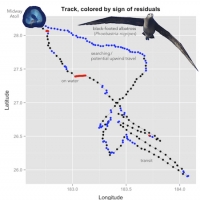 |
Assessment of Citizen Science Collected Via Whale mAPP, an Android Phone App GEMM Lab graduate students are producinga a citizen science version of Whale mAPP, GIS-based web and mobile tools, to allow citizen scientists to collect observations of marine mammals. |
 |
Assessment of gray whale vessel response to inform community developed Oregon’s vessel operation guidelines around whales Investigators: Florence Sullivan, Dr. Leigh Torres |
 |
Bryde’s Whales, Prey, and Vessel Distribution in the Hauraki Gulf, New Zealand In collaboration with colleagues at the University of Auckland, a research project is underway to understand the population size of Bryde’s whales and their foraging and habitat use ecology within the Hauraki Gulf. |
 |
Cetacean use of sensory systems in foraging ecology Much of how whales and dolphins find food remains a mystery to scientists. These animals are equipped with multiple sensory systems that are well-developed for use in the marine environment – sight, sound, touch, smell, and biomagnetism - but each sense’s ability to increase feeding opportunities depends on the distance to the target, called ‘the scale’. |
 |
Distribution of Marine Mammals off the Oregon Coast Relative to Marine Renewable Energies GEMM Lab graduate students will be combining passive-acoustic and visual surveys to effectively monitor marine mammals in Newport, Oregon’s near shore waters. |
 |
Documentation of Fisheries Overlap and Behavioral Impacts on New Zealand Albatross The GEMM Lab works closely with colleagues in New Zealand (NIWA) to improve our understanding of seabird-fishery interactions. |
 |
Evaluation of sea otter reintroduction to the Oregon coast Sea otters were once abundant along the entire west coast of the United States, including Oregon - according to historical hunting records, tribal archives, and archaeological findings. However, due to unsustainable and intense hunting pressure from fur traders, sea otters were pronounced locally extinct in the early 1900’s. |
 |
Habitat assessment of humpback whale breeding grounds in New Caledonia, with predictive model development for the Oceania region Humpback whales visiting the New Caledonian breeding grounds have been subject to a long term monitoring program since 1993 thanks to the efforts of Dr Garrigue, senior researcher at the Institute of Research for Development and scientific advisor to the local Opération Cétacés NGO. |
 |
Habitat Use Patterns of New Zealand Sea Lions, Southern Elephant Seals and Great White Sharks The GEMM Lab is working to improve understanding of the habitat use patterns of great white sharks, New Zealand sea lions, and southern elephant seals. |
 |
Individual-Based Fine-Scale Analysis of Maui's Dolphin Habitat Use The critically endangered Maui’s dolphin of New Zealand has a restricted home range between Port Waikato and the Manukau Harbour along the west coast of North Island, but little is known about their fine-scale movement patterns within this area. Bycatch in setnet and trawl fisheries are the main causes of population declines, so it is critical that dolphins and these fishing activities are separated in space and time. |
 |
OBSIDIAN: Observing Blue whale Spatial ecology to Investigate Distribution In Aotearoa New Zealand Drawing on multiple lines of evidence, the GEMM Lab has documented a population of blue whales in New Zealand that are genetically distinct and present year-round. Ongoing research efforts will enhance our understanding of this recently documented population and inform management. |
 |
Population and Ecology of Southern Right Whales at Campbell Island A field team will spend a month on remote Campbell Island in winter 2014 to collect distribution data, photo-ID data, and tissue biopsy samples from the rarely studied southern right whale population. |
 |
Residence in Space and Time (RST): A new and simple way to classify behavior states in movement data Large animal movement datasets are increasingly common (see https://www.movebank.org/ or http://www.seabirdtracking.org/) and there is a need for efficient methods of data exploration that adjust to the individual variability of each track. |
 |
Where do New Zealand sea lions and fisheries cross? Of the six extant species of sea lions around the globe, three are endangered, including the New Zealand sea lion. The GEMM Lab collaborated with scientists in New Zealand to assess the distribution and foraging ecology of sea lions breeding at Campbell Island, with a primary goal to describe their overlap with fishing events in the region. |